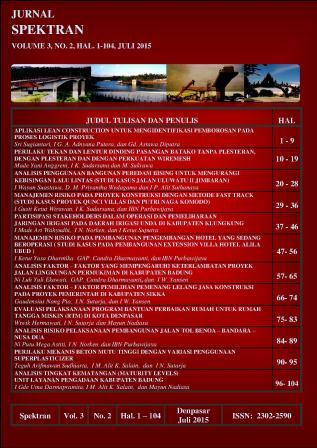APLIKASI LEAN CONSTRUCTION UNTUK MENGIDENTIFIKASI PEMBOROSAN PADA PROSES LOGISTIK PROYEK
Abstract
Construction logistics process hides some non value added activities which are difficult to avoid, those activities have extended leading time which are not only cause the delay of the project completion, but also spend more production expenses that effect to the profit itself.
Data rising by questionnaire is conducted in 22 qualified contractors around Denpasar with 3 respondents in each contractor. Data raising by questionnaire is done in 2 stages, first stage is questionnaire which identify wastes. Second stage are questionnaire which determine waste causes. Field observation is aimed to create a value steam mapping of construction logistic process.
It had been found 7 types of wasting which often occurs. They are the field inspection, the purchase of one type material in different suppliers, awaiting the instruction of the owner, the delay of the material transportation, the purpose of approval or additional signature, clarification needs, awaiting the instruction of the superior. Afterwards, the cause of each wasting, namely the workers inspected are less skilled, the bad quality of goods given by the suppliers, the owner procedures which require workers await the instruction before working, material loading-unloading and distribution process is too slow, a complicated bureaucratic system and unclear information. And from the observation, it is obtained that there are some non-added activities occurred throughout the value stream of the construction project logistics, among them awaiting the approval of the supervisors, transportation, awaiting the order process which is still done manually and product defects during the material selection. As a wasting reduction, it is necessary to simplify the process, create a standard operation procedure, provide enough training to the workers so they are more independent, use an information technology to ease the delivery of the report, hold a long-term contracts with the suppliers and the internal customers.




